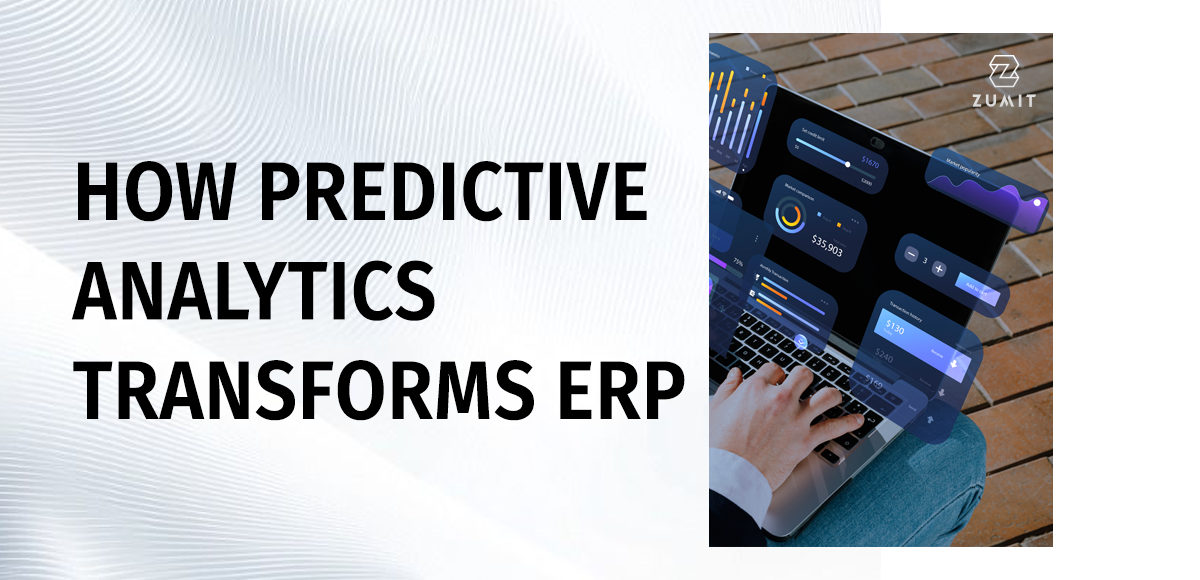
How Predictive Analytics Transforms ERP
Predictive analytics is revolutionizing Enterprise Resource Planning (ERP) systems by enabling organizations to anticipate future trends, optimize operations, and make data-driven decisions. By leveraging historical data and statistical algorithms, predictive analytics transforms raw information into actionable insights, enhancing the strategic value of ERP systems.
- Understanding Predictive Analytics in ERP:
Predictive analytics is a branch of advanced analytics that employs historical data, statistical algorithms, and machine learning techniques to anticipate future events, behaviors, and outcomes. Within Enterprise Resource Planning (ERP) systems, predictive analytics plays a pivotal role by transforming vast amounts of collected data into actionable insights, thereby enhancing decision-making processes and operational efficiency.
Significance of Predictive Analytics in ERP Systems
ERP systems serve as centralized repositories, integrating data from various business functions such as finance, human resources, supply chain, and customer relationship management. This integration provides a holistic view of an organization’s operations. By embedding predictive analytics into ERP systems, organizations can:
- Enhance Forecasting Accuracy: Predictive analytics utilizes historical data to forecast future trends, such as sales projections, inventory requirements, and budget allocations, enabling businesses to plan proactively.
- Optimize Resource Allocation: Anticipating future demands allows for efficient allocation of resources, ensuring that production schedules, staffing, and supply chain operations are aligned with projected needs.
- Mitigate Risks: By identifying potential issues before they arise, such as equipment failures or supply chain disruptions, organizations can implement preventive measures to minimize downtime and associated costs.
Utilization of Historical Data in Predictive Models
Predictive models operate by analyzing patterns within historical data to forecast future outcomes. The process involves several key steps:
- Data Collection: ERP systems aggregate data from various departments, capturing information on transactions, operations, and interactions.
- Data Cleaning and Preparation: Collected data is cleansed to remove inconsistencies and inaccuracies, ensuring the quality and reliability of the dataset.
- Pattern Recognition: Statistical algorithms and machine learning techniques analyze the prepared data to identify trends, correlations, and anomalies.
- Model Development: Based on recognized patterns, predictive models are constructed to represent the relationships within the data.
- Forecasting: The developed models are applied to current data to predict future events or outcomes.
For example, in supply chain management, predictive models can analyze past sales data, seasonal trends, and market conditions to forecast future product demand. This enables businesses to adjust procurement and production plans accordingly, reducing the risk of overstocking or stockouts.
By leveraging historical data through predictive analytics, ERP systems empower organizations to transition from reactive to proactive management strategies, fostering improved efficiency, reduced costs, and enhanced competitiveness in the market.
2.Benefits of Integrating Predictive Analytics into ERP:
Integrating predictive analytics into Enterprise Resource Planning (ERP) systems offers several significant benefits:
1. Enhanced Decision-Making
Predictive analytics empowers organizations to make informed strategic decisions by providing foresight into market trends and operational performance. By analyzing historical data and identifying patterns, businesses can anticipate future scenarios and adjust their strategies accordingly. For instance, predictive models can forecast customer demand, enabling companies to tailor their marketing efforts and optimize product offerings to meet anticipated needs.
2. Operational Efficiency
By leveraging predictive analytics, organizations can optimize various operational aspects, including resource allocation, production scheduling, and inventory management. Accurate demand forecasting allows businesses to maintain optimal inventory levels, reducing the risk of overstocking or stockouts. Additionally, predictive insights can streamline production processes by anticipating potential bottlenecks and enabling proactive adjustments to workflows.
3. Risk Mitigation
Predictive analytics enhances risk management by identifying potential risks and anomalies before they escalate. By analyzing patterns in data, organizations can detect early warning signs of issues such as equipment failures, financial discrepancies, or supply chain disruptions. This proactive approach allows businesses to implement preventive measures, thereby minimizing downtime and mitigating potential losses.
Incorporating predictive analytics into ERP systems transforms raw data into actionable insights, enabling organizations to navigate complexities with greater confidence and agility.
3.Technological Enablers:
Integrating Artificial Intelligence (AI) and Machine Learning (ML) into Enterprise Resource Planning (ERP) systems significantly enhances predictive analytics capabilities, leading to more accurate forecasts and informed decision-making. However, the effectiveness of these predictive models heavily depends on the quality and integration of data from various business functions.
Role of AI and ML in Enhancing Predictive Capabilities within ERP Systems
AI and ML technologies transform traditional ERP systems into intelligent platforms capable of advanced data analysis and forecasting. By processing vast amounts of data in real-time, these technologies identify patterns and trends that might be imperceptible through manual analysis. This capability allows businesses to anticipate future events, optimize operations, and make data-driven decisions. For instance, AI-powered ERP systems can automate routine tasks, provide real-time insights, and enhance decision-making processes.
In supply chain management, ML algorithms analyze historical data to predict demand fluctuations, enabling companies to adjust procurement and production schedules proactively. This predictive approach minimizes inventory costs and reduces the risk of stockouts or overproduction.
Importance of Data Quality and Integration for Accurate Predictions
The accuracy of predictive analytics in ERP systems is fundamentally linked to the quality and integration of data across various business functions. High-quality data ensures that predictive models are built on reliable information, leading to trustworthy insights. Conversely, poor data quality can result in inaccurate predictions, misguided strategies, and potential financial losses.
FasterCapital
Effective data integration consolidates information from disparate departments—such as finance, sales, and operations—into a unified system. This holistic view allows predictive models to consider multiple variables and interdependencies, enhancing their accuracy and relevance. For example, integrating sales forecasts with inventory levels and supplier lead times enables more precise demand planning and inventory management.
To maintain data quality and integration, organizations should implement robust data governance practices, including regular data validation, cleansing, and standardization. Additionally, fostering a culture that emphasizes the importance of data accuracy and cross-functional collaboration can further enhance the effectiveness of predictive analytics within ERP systems.
In summary, the synergy between AI, ML, and high-quality, integrated data empowers ERP systems to deliver advanced predictive analytics. This integration enables organizations to anticipate market trends, optimize operations, and make informed strategic decisions, thereby gaining a competitive edge in today’s dynamic business environment.
5.Challenges and Considerations:
Integrating predictive analytics into Enterprise Resource Planning (ERP) systems offers significant advantages but also presents several challenges and considerations that organizations must address:
1. Data Privacy and Security Concerns
Predictive analytics often requires access to extensive datasets, some of which may contain sensitive information. Ensuring the privacy and security of this data is paramount, as inadequate protections can lead to unauthorized access, data breaches, and non-compliance with regulations. For instance, integrating AI tools without proper oversight can inadvertently expose confidential data, emphasizing the need for stringent data governance and security measures.
Panorama Consulting Group
2. Need for Skilled Personnel
The effective development, interpretation, and application of predictive models necessitate a team with specialized skills in data science, statistical analysis, and industry-specific knowledge. However, there is a notable shortage of professionals possessing this combination of expertise, making it challenging for organizations to build and maintain such teams. This skills gap can hinder the successful implementation and utilization of predictive analytics within ERP systems.
Third Stage Consulting
3. Ensuring Organizational Readiness and Cultural Acceptance
Adopting predictive analytics requires more than just technological integration; it demands a cultural shift towards data-driven decision-making. Organizations must assess their readiness by evaluating factors such as leadership support, employee data literacy, and openness to change. A lack of alignment in these areas can impede the effective use of predictive analytics, underscoring the importance of fostering a culture that values and understands data-driven insights.
By proactively addressing these challenges—implementing robust data security protocols, investing in talent development, and cultivating a supportive organizational culture—businesses can enhance the successful integration of predictive analytics into their ERP systems, thereby unlocking its full potential to drive informed decision-making and operational efficiency.
- Use Case: Predictive Analytics in Infor CloudSuite Industrial (CSI)
Infor CloudSuite Industrial (CSI) exemplifies the integration of predictive analytics within an Enterprise Resource Planning (ERP) system, particularly in the manufacturing sector. By harnessing predictive analytics, CSI enables manufacturers to enhance production planning through data-driven insights, leading to improved efficiency, reduced costs, and increased customer satisfaction.
Enhancing Production Planning with Predictive Analytics in CSI
Effective production planning is crucial for manufacturers to meet delivery deadlines, optimize resource utilization, and maintain cost efficiency. Infor CloudSuite Industrial leverages predictive analytics to transform production planning in the following ways:
- Demand Forecasting: By analyzing historical sales data, market trends, and customer orders, CSI predicts future product demand. This enables manufacturers to adjust production schedules proactively, ensuring that supply aligns with anticipated demand and reducing the risks of overproduction or stockouts.
- Resource Optimization: Predictive analytics assesses data on equipment performance, workforce availability, and material supply to forecast potential production bottlenecks. Manufacturers can use these insights to allocate resources more effectively, schedule maintenance during non-peak times, and balance workloads across production lines, thereby enhancing overall efficiency.
- Production Scheduling: CSI utilizes predictive models to simulate various production scenarios, taking into account factors such as machine capacities, labor shifts, and raw material availability. This allows planners to create optimized schedules that minimize downtime, reduce lead times, and improve on-time delivery rates.
- Quality Management: By analyzing data from past production runs, including defect rates and process deviations, CSI’s predictive analytics can identify patterns that may lead to quality issues. Manufacturers can then implement corrective actions in advance, ensuring consistent product quality and reducing waste.
Incorporating predictive analytics into production planning through Infor CloudSuite Industrial empowers manufacturers to make informed decisions, enhance operational efficiency, and respond swiftly to changing market demands. This strategic approach not only improves internal processes but also strengthens the organization’s ability to deliver high-quality products on time, fostering greater customer satisfaction and competitive advantage.
Integrating predictive analytics into Enterprise Resource Planning (ERP) systems, exemplified by Infor CloudSuite Industrial (CSI), significantly enhances manufacturing operations. By leveraging historical and real-time data, manufacturers can anticipate equipment failures, optimize inventory levels, and refine production planning. This proactive approach leads to reduced downtime, cost savings, and improved customer satisfaction. As demonstrated in various case studies, the strategic application of predictive analytics within ERP systems empowers manufacturers to make informed decisions, streamline operations, and maintain a competitive edge in the dynamic market landscape.


Leave a Comment